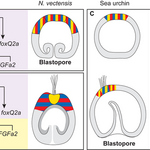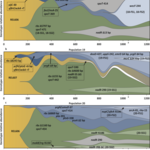Evolution

A year or so back Carl Zimmer asked the science world if life could be defined in three words.I don’t think he would have been too concerned if the answer was in four or five or six words, the point of his question, I believe, was that for a definition of life to be useful, it has to be concise, and therefore, simple, understandable.
I proposed that life could be defined in three words – independent spontaneous cooperation – an argument that I first put here at Science 2.0 in early 2009 with What Is Life? and in subsequent variations on the theme in The Problem With Defining Life, Jack…

In many animals, the brain is located in a specific structure like the head, along with sensory organs and often together with the mouth.
However, there are distantly related animals which have a nervous system but no brain, like sea anemones and corals.
In a new paper, the sea anemone Nematostella vectensis was used to find out if one of the ends of the sea anemone corresponds to the head of higher animals. To do this the researchers studied the function of genes that control head development in higher animals during the embryonic development of the starlet sea anemone.
"Despite…

Understanding how and why diversification occurs is important for understanding why there are so many species on Earth. A new study found that similar, or even identical, mutations can occur during diversification in completely separate populations of E. coli evolving over more than 1,000 generations.
The new study involved 3 different populations of bacteria. At the start of the experiment, each population consisted of generalists competing for two different sources of dietary carbon (glucose and acetate), but after 1,200 generations they had evolved into two coexisting types…

About 45 years ago, Penn evolutionary biologist a
Daniel Janzen reasoned
that change in species from site to site across mountain ranges in the tropics should be greater than in temperate latitudes
Janzen's dispersal hypothesis was that the great difference between summer and winter in temperate latitudes (high seasonality) offers a wide window to migrate across mountainous regions. The small difference in the tropics (low seasonality) allows a very narrow opportunity, annually. Consequently, communities across tropical mountains should have fewer of the same species. Some studies…

Maybe it is not just sentimental. Perhaps the connection to "man's best friends" is literally in our heads.
Skull shape is a complex trait, involving multiple genes and their interactions. Thanks to standardized canine breeding, which documents more than 400 breeds worldwide, and their distinct morphological features, researchers can disentangle traits such as skull shape, which is often a breed-defining variation.
For example, researchers are beginning to identify which genes cause a Bulldog or a Pug to have short pushed-in faces, or brachycephaly, and those that cause Saluki's or…

Almost two years ago, I wrote an article entitled "What is life - Part 1" describing various aspects of life that dealt with the issues of "intent" and "purpose". These are obviously heavily loaded terms, and represent a tremendous difficulty in defining life and trying to come to terms with the obvious and yet inexplicable behaviors we see.
Yet, we all recognize this type of behavior and biology even uses the term teleonomy to characterize this (1).
Now, the problem faced in biology is that we have these "purposeful" systems called organisms, and yet we must simultaneously recognize…

Want to feel small? Humans have been included in the most comprehensive tree of life to-date on placental mammals. And placental mammals are the largest branch of the mammalian family tree, with more than 5,100 living species.
The ancestor of all placental mammals was a tiny, furry-tailed creature that evolved shortly after the dinosaurs disappeared. The paper in Science details how researchers used both genetic and physical traits to reconstruct the common ancestor of placental mammals, the creature that gave rise to many mammals alive today. They show that, contrary to a commonly held…

You would think
after thirty years of numerous critics exposing the shortcomings of the selfish
gene hypothesis, that its proponents would have become a little more
circumspect, a little more nuanced in their promotion of the fallacy. But you’d
be wrong.
About a year ago
that old gene-warrior Jerry Coyne went in boots-and-all on his blog against DS
Wilson, and all because Wilson took Richard Dawkins to task over group
selection.
Coyne gave a
portion of Wilson’s article, and followed it with this;
“This is sheer
madness – an almost incoherent rant...Yes, genes are replicators, but…

To many, DNA represents the definitive code which governs all life. It has been compared to a sophisticated computer program from which every aspect of an individual organism is built.
Equally it has been stated that DNA is not destiny, so there is some basic recognition that DNA is not the absolute arbiter of everything biological.
However, we find that there is still a general reluctance to reduce the prominence of DNA from our understanding of biological systems. There's no question that it is an important central figure in development, but it is only part of the process.…

An international team of researchers sequenced nuclear and mitochondrial DNA that had been extracted from the leg of an early modern human from Tianyuan Cave near Beijing, China and found that the human from 40,000 years in China is related to many people on multiple continents.
Analyses of this individual's DNA showed that the Tianyuan human shared a common origin with the ancestors of many present-day Asians and Native Americans. In addition, the researchers found that the proportion of Neanderthal and Denisovan-DNA in this early modern human is not higher than in people living in this…